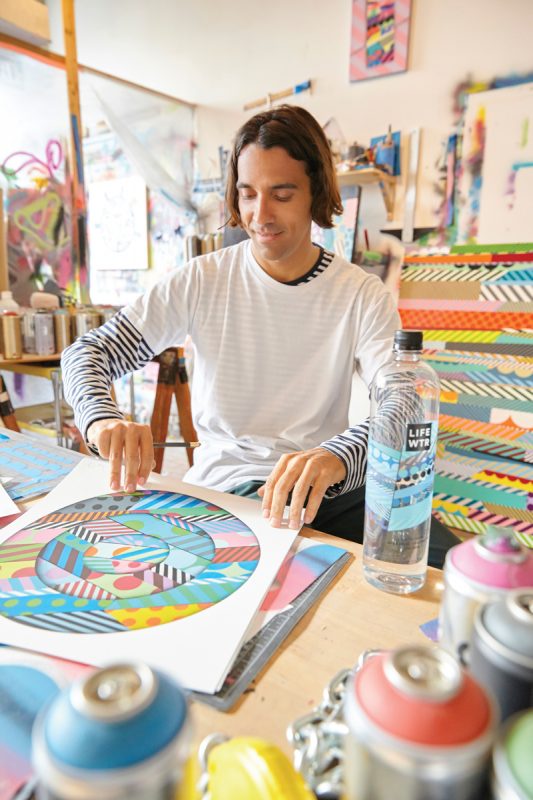LIFEWTR, a new H20 brand from PepsiCo, was created with a clear purpose—to give emerging creatives a platform to publish their work. Brad Jakeman, president of PepsiCo’s global beverage group, and Olga Osminkina-Jones, VP of hydration, divulge their plan to democratize art, three labels at a time.
Why did PepsiCo create LIFEWTR?
Olga Osminkina-Jones: Just as water is essential to life, we believe inspiration is essential to life. The water in LIFEWTR is one of the highest-quality waters on the market, but it’s much more than water. We built this brand with a mission, which is to advance and showcase creativity. What we champion is giving a voice and a platform to emerging talent.
Brad Jakeman: I think that anybody can put art on a bottle, but we’re creating a brand that is all about supporting emerging artists, and one expression of that is their artwork on the bottle.
What are some other ways that LIFEWTR will support these artists?
Olga: The water is a canvas for emerging artists, but it only starts with the label. Any artist that’s showcased on the label will be equally showcased in every touchpoint that we will activate LIFEWTR through. You will see them at our parties and in any content or storytelling that we’ll do with LIFEWTR. We partner with many established people in the creative and art worlds, and they help us to mentor and propel the creators that we choose.
Brad: As we’ve talked to emerging artists, whether they be painters, fashion designers, or photographers, they talk about having their art presented to a great number of people. That’s how they get popularized and commercialized. Showings at galleries have historically been where artists present their art to many people. In essence, we are publishing their art in the broadest possible way. A huge movement in art now is about democratizing art, and what better way to give art accessibility than a nationally distributed canvas that’s in millions of people’s homes around the world?
How did you choose the first three artists?
Olga: The three artists in Series 1—Craig & Karl, MOMO, and Jason Woodside—are all public-art artists. Not so long ago, they had their first break. They each had a platform that helped them to accelerate their career. Who better than artists like this, who know the power of the right force behind them, to tell the story of LIFEWTR to the next generation of creators? Moving forward, you will see LIFEWTR giving a voice to even more emerging talent that will represent different cultural moments in the world.
What was the collaborative process like?
Olga: We don’t approach the artists with a marketing brief. We want the artists to find their own way and project their own voice. Through our partners, we find the right artists to represent the cultural phenomenon we want to amplify, and we ask them to give us their best work that represents who they are. We allow them to be themselves. For any creator, I think that’s the most important thing.
We have to ask: What is the reason for the absence of vowels in “WTR”?
Olga: We want to make a stance that we are contemporary. I think we all know that dropping vowels is the trend today. So we are in tune!
Brad: It’s the language of a digital era, a language of limited characters and hashtags.
Brad, tell us about the Design & Innovation Center and why you created the chief design officer role.
Brad: The Design Center has been operating for more than three years. Consumers don’t just buy products, they buy brands. It’s about how they’re packaged, the label, the experiences created around the consumer. We have found that it’s not only the quality of our design that has increased since we brought on the Design Center, but so too has efficiency. Many have asked, are you getting the same quality of people who want to join PepsiCo versus the quality of people who want to join a design agency? We’re actually getting a higher quality of people. They’re closer to where the decisions are taking place. They’re not taking their work to a client and asking them to buy their ideas. Design-led thinking is important at PepsiCo.
There is a significant amount of art inside and outside the HQ in Purchase, New York.
Brad: An important part of our culture at PepsiCo has been supporting emerging artists, even back to our founder, Don Kendall, and the personal relationships he had with artists like Picasso and Calder. Our campus is a visual representation of our commitment to art. So the idea behind LIFEWTR is much more authentic coming from PepsiCo, which has a 50-year relationship with the art community globally. Our sculpture garden is open to the public. It’s a public-facing piece, just like the water. Like LIFEWTR, it’s democratizing art and giving access to art to everybody.
What will we see next from LIFEWTR?
Brad: Several times a year, we will issue a new series of LIFEWTR. Each one of those series will be grounded in an idea. Coming out with a new series will maintain an excitement around this brand, and it will allow us to touch more emerging artists. Think of our bottles as a publishing media, or a clear plastic gallery, where we will be publishing this amazing artwork.
Olga: Anywhere you go in the world, there are emerging artists who are just trying to be heard. There are people all over the world that we want to reach. We want to create a global impact and a global conversation.
Read the issue HERE.





